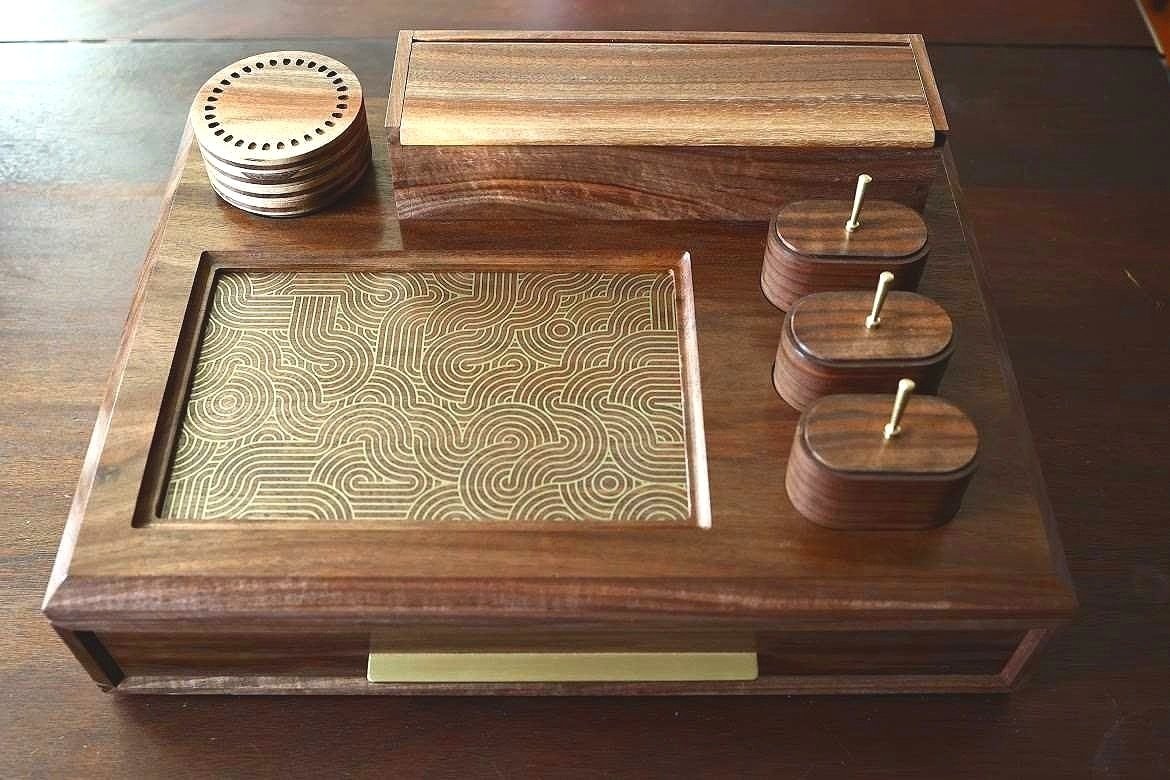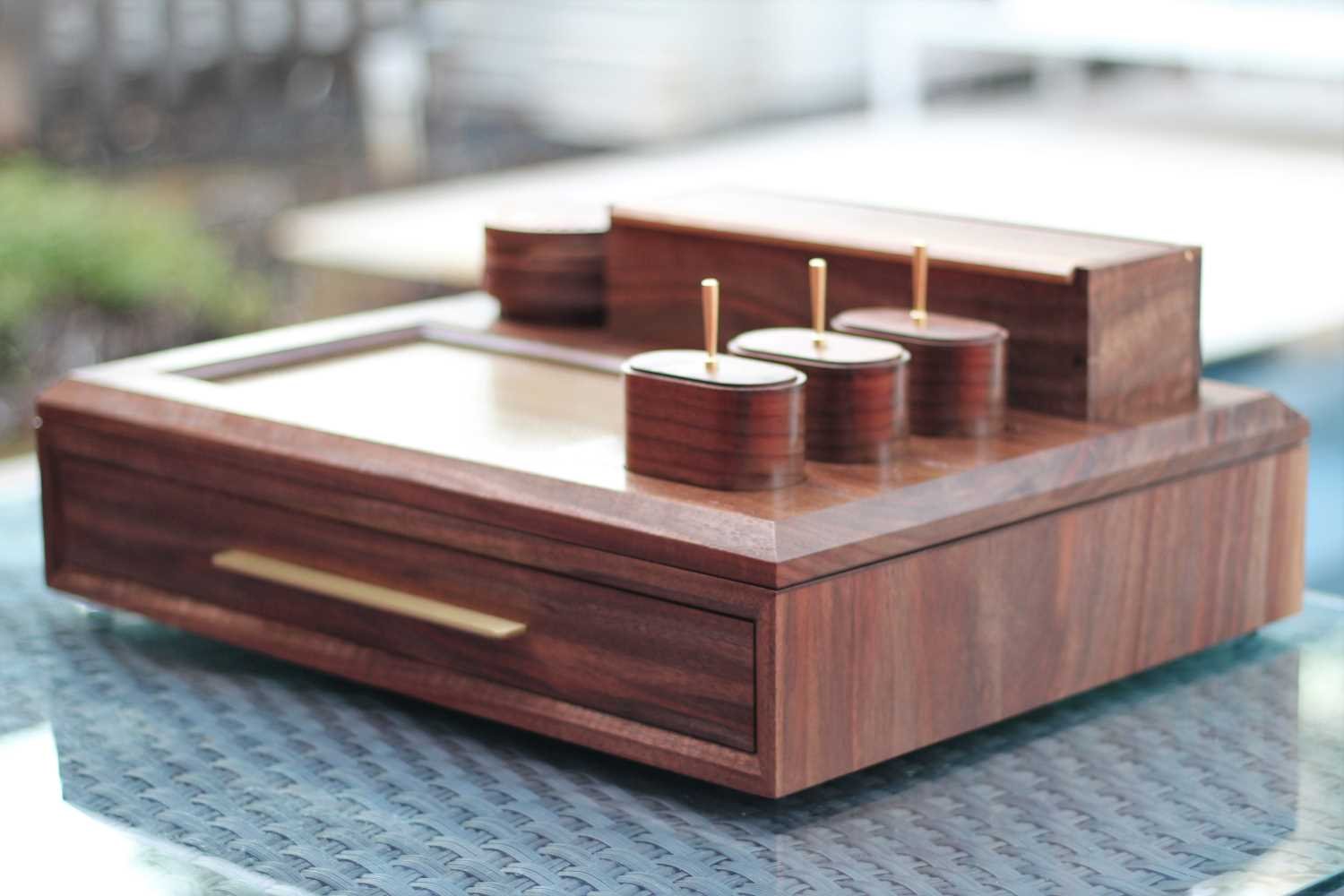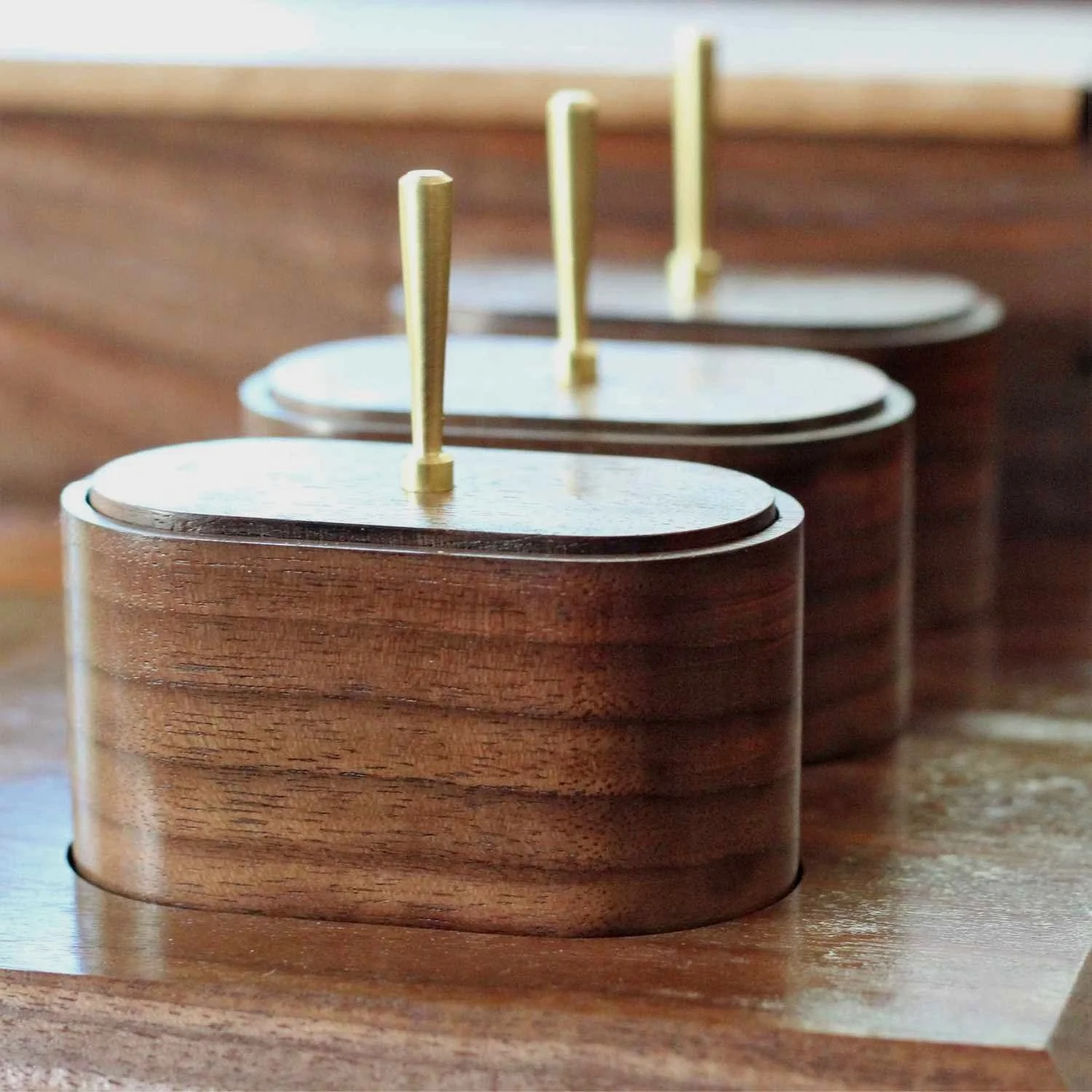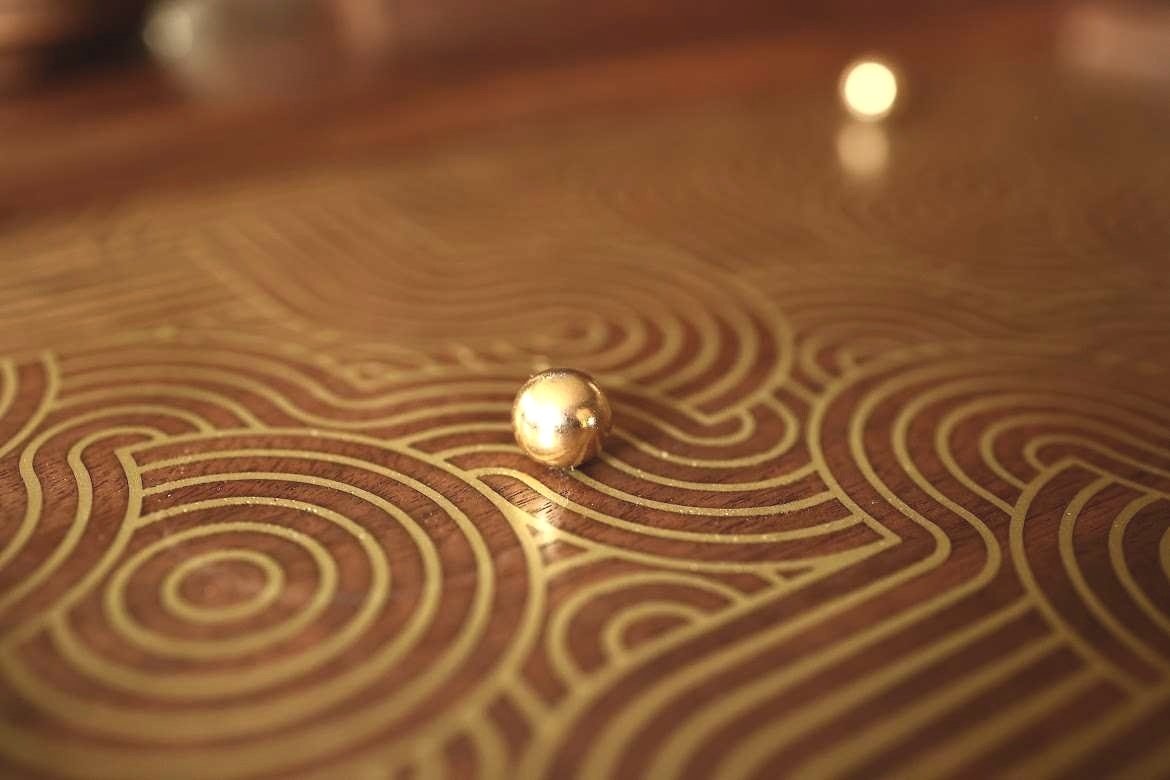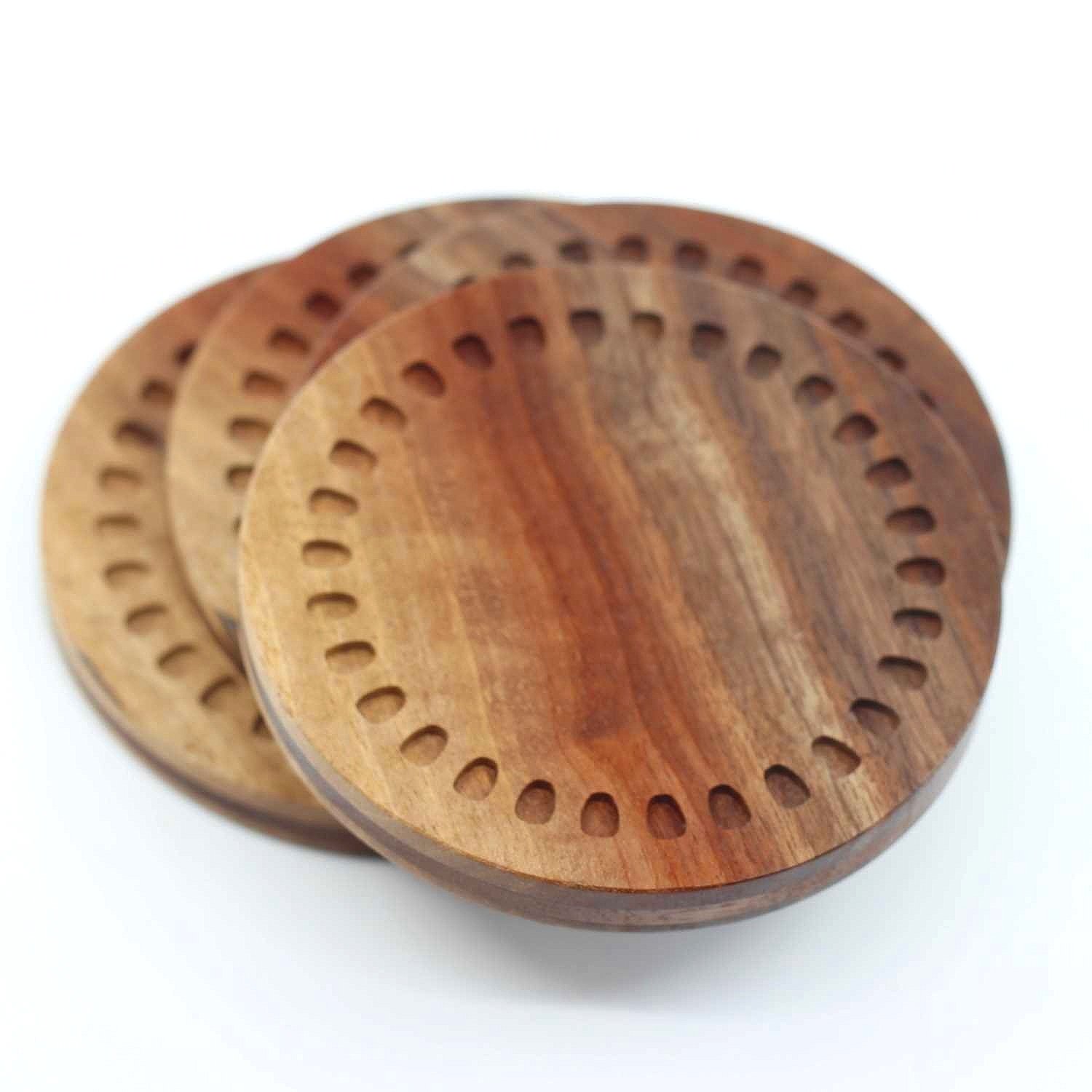Tray Chic
EveryDay Puzzle Tray
I’d like to take a moment to say thanks, and share something special with everyone. This time of year is always a good reminder to step back and appreciate the things we have in our lives that are most important. To me that means my family, and my ability to care for people in my career. For all of that I am exceedingly grateful. I’m also incredibly lucky to enjoy this eclectic and unusual hobby of mine, and to be able to share some of my joy with friends around the world through this weekly offering.
The EveryDay Puzzle Tray by Paul Jasper and Robert Yarger
photo courtesy of Paul Jasper
I made a new friend recently, Dr. Paul Jasper from Boston, Massachusetts. Paul is a PhD scientist with MIT and Harvard credentials whose expertise is in building mechanistic mathematical models of biological systems. Soon after receiving his PhD, he began his other passionate pursuit into woodworking, training at The Furniture Institute of Massachusetts and The North Bennett Street School before apprenticing with a fine furniture maker and restorer in Boston. He now crafts heirloom quality pieces under his own label, Copper Pig Woodworking. His line includes beautifully crafted functional art for everyday use, and for a long time I marveled at his “EveryDay Trays”, which feature artistic panels and containers made from highly figured rare woods and meant to store everyday use items such as keys, wallets, watches and whatnots. I always thought that one of those trays might be an ideal solving station for some of the more intricate puzzles and puzzle boxes I enjoy. Many have little bits, parts, pieces and tools which are revealed or fall out as the puzzle is explored, and are easily lost. A simple cloth to catch everything would do, but I am not known for doing things simply.
I reached out to Paul and inquired if he might consider making one of his EveryDay Trays for me, but perhaps with a twist. Could he, for example, add a secret compartment or two? A puzzling hidden mechanism to unlock something? How about a place to put a nice glass of liquid inspiration, while we are on the subject? Paul graciously agreed to entertain the ideas, and then even more graciously agreed to take on a much more complex challenge than originally planned. During the course of our discussions, puzzle maker and designer Robert Yarger became involved, and eventually he and Paul left me out of the conversations. What resulted is presented here for the first time, the EveryDay Puzzle Tray, a truly beautiful place to puzzle. The tray, which features a main solving panel, a set of storage containers, a handmade dovetail pen box, and a bespoke set of drinks coasters, sits atop a dovetail drawer. Locked inside is a leather bound notebook and some additional details about the incredible piece. Opening the drawer will take you on a journey of discovery and wonder, brought to life magically with a flourish that only Stickman could have invented, as you all the while marvel at Paul’s stunning woodwork fashioned with old school elegance combined with new world technology.
a good book to take note of
photo courtesy of Paul Jasper
Paul provided detailed notes on the piece which are extensive. His mostly unedited descriptions (spoilers removed) can be found on his artist’s page, and are exceedingly worth a read. The tray is crafted from a rare piece of highly figured Black Walnut which Paul found “in Lancaster County, PA at a local lumberyard called Groff & Groff. Black walnut is one of the few domestic species of woods we have in North America that has a rich dark brown espresso color to it. Furthermore, once in a long while, you find a rare FIGURED black walnut tree that has beautiful color variations and striations within the wood. I remember seeing the EXACT board that made your entire tray, stretching nearly 16 feet into the air from the ground and being easily 2-feet wide with the most AMAZING color striations throughout. With design, it is my strong opinion that the piece should match itself internally, meaning all components are from the same tree.” Paul used sections from the board which spanned from the central dark heartwood to the outer light sapwood, and “you can immediately see an almost unspeakably beautiful color gradient going from cream, to light gray, to almost red, and finally to dark brown. Notice the arching grain on the front of the dovetailed box flowing up and down like a nebula, that is present in both the front side and back side of the box (I sawed these from the same piece and carefully aligned them).” Inside the drawer and dovetail box there is lovely contrast provided by figured curly cherry wood.
Details abound on the tray. The set of storage containers are what Paul calls his “Stadia” boxes, which evolved as a non-scientific experiment into the human preference for curved shapes. He found that these pretty little boxes, shaped like a stadium (a geometric shape composed of a rectangle and two semicircles at each end), sold out very quickly when he first introduced them, and he has made them ever since. On the puzzle tray, made from black walnut with hand turned solid copper pulls, they provide a soft contrast to the square corners, and also hide a secret.
The main tray panel was made from black walnut inlayed with brass. “The pattern was routed on my CNC machine one line at a time using a very small 1/16" bit, and then back filled with a slurry of slow cure epoxy mixed with a high percentage of actual brass powder.” The pattern on the tray is known as “Truchet Tile” and is an example of computer-generative art. Paul explains, “One of the patterns I fell in love with almost instantly was based on a geometry known as a Truchet Tile. "Truchet tiles were first described in a 1704 memoir by Sébastien Truchet entitled "Mémoire sur les combinaisons", and have become a favorite geometry of computer generative artists such as my friend Rev. Daniel Catt. Dan created a random truchet tile generator in which the user can change any number of input values and it will have an effect on some aspect of the randomly generated pattern and generously shares it with the world. I used Dan's generator to make the pattern you see in the center of the puzzle tray.”
computer-generative Truchet Tile patterns modeled by Rev. Daniel Catt
photo courtesy of Paul Jasper
The lovely freestanding pen box was intentionally made with very traditional techniques to balance the high-tech nature of the main tray. “I decided we needed a piece of old-world craftsmanship to balance it, such as a beautiful traditional hand-cut dovetailed box.” The stunning color gradations seen along the hinged top of the box are mirrored in the novel coasters next to it, which were made with bespoke black walnut layered ply for stability and finished with a combination of oil and wax, as opposed to the traditional furniture shellac applied to the rest of the piece, in case of alcohol spills which would erode the shellac.
the beauty of black walnut sapwood
Paul was in his element and state of “flow” while crafting the components of the piece. “This tray is so interesting in some ways because it combines elements of fine furniture from many centuries ago with absolutely cutting edge modern technology. Techniques [employed] include inlay, hand-cut dovetails, hand-planed surfaces, solid brass milling, brass epoxy inlay, custom plywood fabrication, classic drawer construction, [and] classic box construction.” But he stepped outside of his comfort zone to create the mechanisms from Robert Yarger’s brilliantly puzzling mind. Paul admits this part was easily the most challenging and frustrating aspect for him, but his confidence never wavered. “Maybe emotionally I might feel flustered one day but intellectually, I know I will ultimately find a solution. Also my science expertise is building mathematical models of biological systems so there is a lot of engineering and mechanistic thinking involved.” On the other hand, working with Rob was a true pleasure for him. He notes the experience was “Brilliant. Rob was responsive, understanding, clever & creative, open-minded to revision or pivoting and helped me all along the way. I couldn't have asked for a better experience working together and I'm sure we'll stay in touch from this point forward. Robert is a gem in this puzzle community and what a fantastically clever individual.” I couldn’t agree more.
I also couldn’t conclude this piece any better than Paul does. “I think that nicely tells the story of your puzzle tray and everything that went in to making it what it is, spanning generations of woodworking techniques from centuries ago (hand-cut dovetails), to modern innovations of today (CNC), from cow hide glue to modern epoxy adhesives, from 3D printed gears to the most beautiful figured air-dried black walnut, from friendships formed around computer generative art and puzzle mechanism design, to experiments in human preference with curvilinear design. So much goes into every single piece I make, which is why I choose which commission I accept carefully, as it takes a piece of my life with it. What I hope most is that the pieces I make bring daily joy to their owners and remind them of our shared connection, our mutual love of high-quality hand crafted, thoughtful, and deliberately designed craft.”
Charming Man by Joaquin Simo
Here's a toast to Paul Jasper, a charming man. The drink is a modified mezcal Negroni, perhaps the most delicious variation on the traditional format, which I don’t need to tell you is an equal parts combination of gin, sweet vermouth and Campari. It was originally created at New York’s Pouring Ribbons by Joaquin Simo, a modern legend who has made his mark with many well known modern cocktails. Simo, who was part of the opening team at Death and Company, was awarded the American Bartender of the Year at the 2012 Spirit Awards.
Here the gin is replaced by smoky mezcal, the vermouth by the deeply rich and delicious East India Solera sherry from Lustau, and the Campari by the smoky and bitter amaro Sfumato Rabarbaro, made from the root of the Chinese rhubarb plant. The amaro is particularly rewarding this time of year, with its darker flavor profile. The name “sfumato” derives from the Italian word “fumo” for smoke which is more traditionally associated with a style of Renaissance painting. The sherry is also a decadent treat, a combination of 80% Oloroso and 20% Pedro Ximenez, aged for twelve years before combining and then three more years in solera casks. It is an homage to 17th century sherry which was taken along shipping routes to the East Indies initially as ballast and crew rations, but improved during the journey due to the heat and constant movement, into something wonderful. Here’s to old world charm and magical transformation.
Charming Man by Joaquin Simo
1 oz mezcal (Del Maguey Vida)
1 oz Lustau East India Solera sherry
1 oz amaro Sfumato Rabarbaro
2 dashes mole bitters
Stir ingredients with ice and strain into a favorite glass. Garnish with an orange peel.
explore more:

